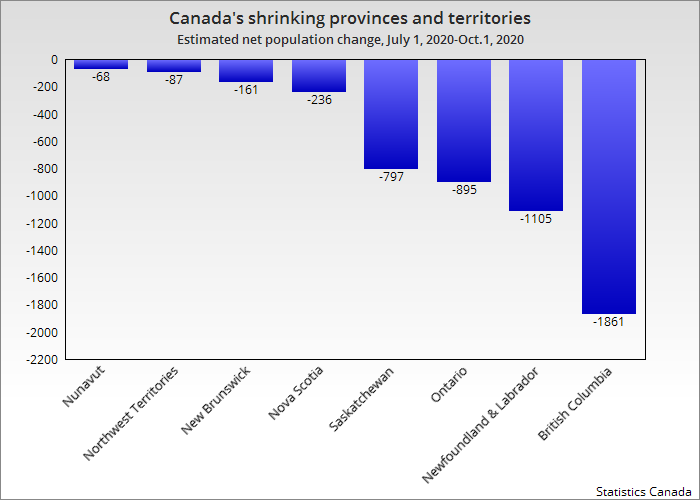
Canada’s population all but stopped growing this summer, and six provinces saw a historic decline in residents, as border shutdowns amid the COVID-19 pandemic kept new landed immigrants from arriving.
Canada’s population increase of 2,767 people in the third quarter of this year is the smallest increase in records going back to 1946, Statistics Canada said in a report released Thursday. It’s so small the statistical agency reported it as 0.0 per cent growth.
In a truly unusual reversal, more permanent residents left Canada than moved to it during this period, with some 27,000 more people emigrating out of the country than immigrating here between July 1 and October 1. It’s only the second time since 1971 that Canada has had more migrants leave than arrive, StatCan said.
Watch: Canada seeks immigration increase for post-pandemic recovery. Story continues below.
It’s not unusual for large numbers of Canadians to leave the country for work, particularly to the U.S., but that loss is generally offset by new arrivals from abroad.
Not so this time, and the result is that six provinces and two territories saw their populations shrink in the third quarter by small margins. It’s the first time any of these places recorded a population decline in records going back to 1951, StatCan said.

The four other provinces and one territory all saw small gains in population, with Alberta in the lead, adding 6,236 people despite hard times in its oil and gas industry.
Canada’s population was also pushed down by COVID-19, which accounted for 706 deaths in the third quarter, after taking 8,495 lives in the first quarter, StatCan said.
The sudden disappearance of Canada’s constant flow of new residents will likely have a profound impact on the economy in the short term and evidence is mounting that this is already happening.
Even as Canada’s house prices soared to new heights this year, rental rates in the largest cities, those with the highest concentration of immigrants, have been in free fall.
On a per-square-foot basis, rents in Toronto are down 20 per cent from a year ago, and down 12 per cent in Vancouver, according to November data from rental site Rentals.ca. Nationwide, rents were down 9.1 per cent in November.
Condo markets in larger cities are also coming under pressure because “that segment of the market is most impacted by immigration flows and the still-elevated unemployment rate among young workers, that is, potential first-time home buyers,” National Bank economists Marc Pinsonneault and Daren King wrote in a report Thursday.
They noted that the Teranet house price index saw the fastest jump for a month of November ever this year, and that followed the strongest-ever October.
But “the upward trend in Canadian home prices does not apply everywhere to all categories of dwellings. In Toronto, the rise in sales was mostly concentrated outside downtown in ground-level dwellings, at the expense of apartments,” the National Bank economists wrote.
“As for Greater Montreal, (realtors) reported a very significant increase in active listings for condominiums on the Island of Montreal, a sharp contrast with the other areas of that region.”
But with the prospect of a vaccine putting an end to the pandemic next year, many economic forecasts assume Canada’s immigration levels will start returning to normal in 2021.
“While international migration will likely be soft in the first half of 2021, once the vaccine is mobilized globally and international travel resumes, we expect international migration to ramp up,” RBC economist Carrie Freestone wrote in a client note Thursday.
“In the second half of 2021, we can certainly expect to see significantly higher levels of non-permanent residents.”
Long-term growth to accelerate
Even as Canada’s population growth currently stagnates, the federal government has increased immigration targets for the years ahead.
The federal Liberals announced last month they are hiking the immigration target to 401,000 new landed immigrants in 2021, rising to 421,000 in 2023. It had previously set targets around the 300,000 mark annually.
“Put simply, we need more workers, and immigration is the way to get there,” Immigration Minister Marco Mendocino said, in announcing the new targets in October.
Though Mendocino said he was confident Canada could meet the 401,000 target in 2021, Conservative immigration critic Raquel Dancho questioned whether Canada could absorb such a high level of migrants at a time of elevated unemployment.
She said the idea Canada could welcome that many immigrants next year amid worldwide border and embassy closures was “pure fantasy.”